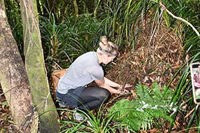
Many people are surprised when I tell them that kiwi can thrive in pine forests. The truth is, kiwi can live just about anywhere, as long as there’s adequate shelter, food, water, and protection from predators. Native forest, pasture, grassland, sand dunes, snow... and, that’s right, plantation forests can all be suitable habitats.
I recently visited Rosewarne’s Crew 83 in Summit Forest’s Whangapoua Forest to present a training session about how to identify if kiwi are present in pine blocks during harvest. Crew 83 is harvesting an area adjacent to Summit’s biodiversity block which is inhabited by, among other wildlife, Coromandel brown kiwi.
The crew mentioned that they had noticed an abundance of native birds while they were working, especially tūī and kererū. This is a direct result of the steps taken to protect and enhance an existing population of kiwi in the Summit’s biodiversity block, especially their ongoing predator control regime. The work that is going on there not only helps to protect kiwi, but it also helps other native flora and fauna to flourish and then disperse into neighbouring areas.
I was also lucky enough to spend a large part of last summer on Ahuahu/Great Mercury Island. Approximately 600 hectares of the southern end of Ahuahu is covered in mature pine forest, surrounded largely by regenerating native coastal forest. In 2013, the owners of Ahuahu and the Department of Conservation worked together to eradicate mice, rats and cats, and in 2016 the island was awarded pest-free status. Sheep and cattle were also excluded from the pine forest and regenerating coastal forest around the same time. Combined, this has allowed for some amazing gains for native biodiversity in and around the plantation forest.
The native understory that flourishes beneath the pine canopy is a manual tree faller’s nightmare, but it is incredible to see and hear the plethora of bird and insect life it supports. Tīeke/saddleback, kākāriki and kākā – just to name a few – are in abundance. Although the plantation forest on Ahuahu will not be harvested, what is happening there is proof that exotic species plantations, if managed sensibly, can provide exceptional habitat for our native species and still be productive commercial forests.
Importantly, if we grow kiwi to abundance in our forests before they are harvested, the odd mishap during harvest will have far less of an impact on the overall kiwi population.
Understanding more about kiwi and pine
To gain a better understanding of how kiwi and commercial plantation forests can co-exist, Save the Kiwi is undertaking an extensive research project into the effects of modern forest harvesting techniques on resident kiwi populations. This research project will track the movements of resident kiwi over five different harvest sites over the next five years in a ‘hands-off’ method, to understand more about how kiwi react to their pine plantation habitat being harvested.
Transmitters will be placed on resident kiwi and their movements will be tracked for six months before harvest begins, to get a baseline...





